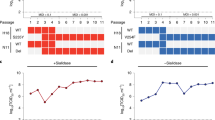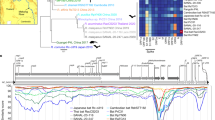Abstract
Haemagglutinin and neuraminidase surface glycoproteins of the bat influenza H17N10 virus neither bind to nor cleave sialic acid receptors, indicating that this virus employs cell entry mechanisms distinct from those of classical influenza A viruses. We observed that certain human haematopoietic cancer cell lines and canine MDCK II cells are susceptible to H17-pseudotyped viruses. We identified the human HLA-DR receptor as an entry mediator for H17 pseudotypes, suggesting that H17N10 possesses zoonotic potential.
This is a preview of subscription content, access via your institution
Access options
Access Nature and 54 other Nature Portfolio journals
Get Nature+, our best-value online-access subscription
$29.99 / 30 days
cancel any time
Subscribe to this journal
Receive 12 digital issues and online access to articles
$119.00 per year
only $9.92 per issue
Buy this article
- Purchase on Springer Link
- Instant access to full article PDF
Prices may be subject to local taxes which are calculated during checkout


Similar content being viewed by others
Data availability
Microarray data are available at the Gene Expression Omnibus (GEO) repository under the series record number GSE14837. All other data supporting the findings of this study are available from the corresponding author on request.
References
Tong, S. et al. Proc. Natl Acad. Sci. USA 109, 4269–4274 (2012).
Tong, S. et al. PLoS Pathog. 9, e1003657 (2013).
Ciminski, K. et al. J. Gen. Virol. 98, 2393–2400 (2017).
Long, J. S., Mistry, B., Haslam, S. M. & Barclay, W. S. Nat. Rev. Microbiol. 17, 67–81 (2019).
Sun, X. et al. Cell Rep. 3, 769–778 (2013).
Zhu, X. et al. Proc. Natl Acad. Sci. USA 109, 18903–18908 (2012).
Juozapaitis, M. et al. Nat. Commun. 5, 4448 (2014).
Wu, Y. et al. Trends Microbiol. 22, 183–191 (2014).
Maruyama, J. et al. Virology 488, 43–50 (2016).
Moreira, E. A. et al. Proc. Natl Acad. Sci. USA 113, 12797–12802 (2016).
Hoffmann, M. et al. PLoS ONE 11, e0152134 (2016).
Carnell, G. W. et al. Front. Immunol. 6, 161 (2015).
Carnell, G. et al. Preprint at https://www.biorxiv.org/content/10.1101/499947v2 (2018).
Dukes, J. D. et al. BMC Cell Biol. 12, 43 (2011).
Roche, P. A. et al. Nat. Rev. Immunol. 15, 203–216 (2015).
Ziegler, A. et al. Immunobiology 171, 77–92 (1986).
Karakus, U. et al. Nature 567, 109–112 (2019).
de Vries, E. et al. Proc. Natl Acad. Sci. USA 109, 7457–7462 (2012).
Giotis, E. S. et al. Sci. Rep. 7, 17485 (2017).
Kall, L. et al. Nucleic Acids Res. 35, W429–W432 (2007).
Krogh, A. et al. J. Mol. Biol. 305, 567–580 (2001).
Almagro-Armenteros, J. J. et al. Bioinformatics 33, 4049 (2017).
Acknowledgements
We thank J. Kaufman, Y. Guo, I. Elbusifi, D. Quinn, A. Ho, K. Ciminski and M. Schwemmle for their support. Cells were kindly provided by E. Wright (University of Sussex, Falmer, UK), K. Paschos, R. White, M. Dorner, M. Edwards, P. Farrell and R. Shattock (Imperial College London, London, UK). This research was undertaken with the financial support of the Biotechnology and Biological Sciences Research Council (BBSRC) (http://www.bbsrc.ac.uk) via the Strategic LoLa grant BB/K002465/1 ‘Developing Rapid Responses to Emerging Virus Infections of Poultry (DRREVIP)’ and the Octoberwoman Foundation. L.-F.W. is supported by the Singapore National Research Foundation grants (NRF2012NRF-CRP001-056 and NRF2016NRF-NSFC002-013).
Author information
Authors and Affiliations
Contributions
E.S.G. conceived, designed and performed the experiments, analysed the data and wrote the manuscript. G.C. generated the luciferase reporter plasmids, produced the pseudotype viral stocks and wrote the manuscript. E.F.Y., S.G. and P.S. performed the microarray work. W.S.B., M.A.S. and N.T. designed the experiments and wrote the manuscript. L.-F.W. provided materials and engaged in discussion of the project.
Corresponding author
Ethics declarations
Ethics statement
The buffy coat residues for the isolation of CD19+ primary B cells were purchased from the UK Blood Transfusion Service from anonymous volunteer blood donors. Therefore, no ethical approval is required.
Competing interests
The authors declare no competing interests.
Additional information
Publisher’s note: Springer Nature remains neutral with regard to jurisdictional claims in published maps and institutional affiliations.
Supplementary information
Supplementary Information
Supplementary Discussion, Supplementary Tables 1 and 2, Supplementary Figs. 1–7 and Supplementary References.
Rights and permissions
About this article
Cite this article
Giotis, E.S., Carnell, G., Young, E.F. et al. Entry of the bat influenza H17N10 virus into mammalian cells is enabled by the MHC class II HLA-DR receptor. Nat Microbiol 4, 2035–2038 (2019). https://doi.org/10.1038/s41564-019-0517-3
Received:
Accepted:
Published:
Issue Date:
DOI: https://doi.org/10.1038/s41564-019-0517-3
This article is cited by
-
Reconstructing the ancestral gene pool to uncover the origins and genetic links of Hmong–Mien speakers
BMC Biology (2024)
-
Structural basis for a human broadly neutralizing influenza A hemagglutinin stem-specific antibody including H17/18 subtypes
Nature Communications (2022)
-
The antiandrogen enzalutamide downregulates TMPRSS2 and reduces cellular entry of SARS-CoV-2 in human lung cells
Nature Communications (2021)



